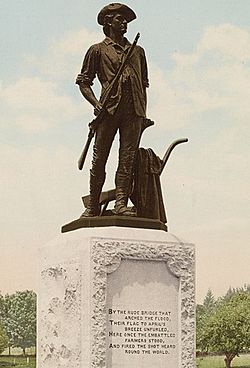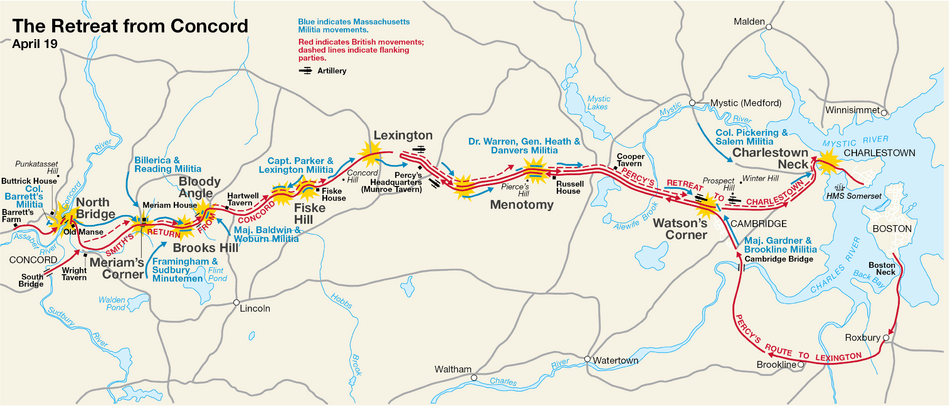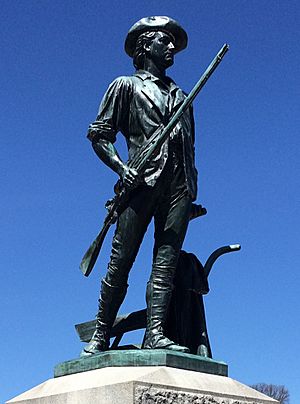The Minute Man facts for kids
 |
|
| Coordinates | 42°28′8.1″N 71°21′4.6″W / 42.468917°N 71.351278°W |
|---|---|
| Location | Minute Man National Historical Park, Concord, Massachusetts |
| Designer | Daniel Chester French (sculptor) James Elliot Cabot (architect) |
| Material | Bronze (sculpture) Granite (pedestal) |
| Height | 7 feet (2.1 m) |
| Opening date | 1875 |
The Minute Man is a famous statue made in 1874 by Daniel Chester French. You can find it in Minute Man National Historical Park in Concord, Massachusetts. The artist spent a lot of time researching before creating it between 1871 and 1874. It was first planned to be made of stone, but they decided to use bronze instead. What's really cool is that the bronze came from ten old Civil War cannons given by the United States Congress!
The statue shows a minuteman (a colonial soldier ready to fight quickly) leaving his farm. He's stepping away from his plow to join the patriot forces. This happened during the Battle of Concord. The young man has his overcoat on his plow and holds a long gun (a type of rifle). Some art experts from the 1800s thought his pose looked like an ancient Roman statue called the Apollo Belvedere. But modern experts, looking at Daniel Chester French's notes, say he used many different statues for ideas, not just that one.
The statue was shown to the public in 1875. This was for the 100-year anniversary of the Battle of Concord. People loved it then, and they still praise it today. The Minute Man has become a symbol for many groups. It was used by women fighting for the right to vote (suffragettes). It also represents the United States National Guard and Air National Guard. You can even see it on coins, like the Lexington–Concord Sesquicentennial half dollar and the Massachusetts state quarter.
Contents
Who Were the Minutemen?
Minutemen were special soldiers who were part of the local army, called the militia, in Massachusetts. They got their name because they were ready to fight in just a minute's notice! This group was formed because the regular militia didn't respond quickly enough to an alarm in 1774.
Unlike the regular militia, which included most white men aged 16 to 60, minutemen were young volunteers. They were paid a small amount to train three times a week. Another big difference was how their leaders were chosen. Regular militia leaders were picked by the governor, often as a political favor. But minutemen chose their own leaders! By February 1775, the town of Concord, Massachusetts had 104 minutemen in two companies.
The Battles of Lexington and Concord
In 1775, the Massachusetts leaders decided to store their cannons, gunpowder, and weapons in Concord. General Thomas Gage, a British leader, sent spies to see what the colonists were doing. Based on these reports, Gage ordered his soldiers to attack Concord and destroy the supplies.
On April 19, 1775, early in the morning, British soldiers met about 70 militiamen in Lexington, Massachusetts. The militiamen had been warned by riders like Paul Revere and William Dawes. No one knows who fired the first shot of the Battle of Lexington. But after a short fight, eight militiamen were killed. The British then moved on to Concord.
In Concord, about 150 minutemen from Concord and Lincoln gathered. They saw the British coming and moved to higher ground without fighting. The British searched the town and destroyed some supplies, like cannons and musket balls. But the gunpowder was moved before they could find it.
While the British were searching, more minutemen and militia arrived. They gathered at the Old North Bridge. There, about 400 minutemen fought the British and made them retreat. Many minutemen went home after this victory. But others kept fighting the British as they marched back to Boston.
Earlier Monument in Concord
In 1825, a group that built the Bunker Hill Monument gave $500 to Concord. This money was for a monument to the Battle of Concord. At first, they planned to put it in the town center. But there were disagreements, so nothing happened until 1835. That year, Ezra Ripley gave land for the monument near the Old North Bridge.
The town then asked Solomon Willard to design a simple granite monument. It was 25-foot-tall (7.6-meter) and was built to celebrate the 60th anniversary of the battle in 1836. A famous writer named Ralph Waldo Emerson wrote a poem called "Concord Hymn" for the monument's dedication. It was sung to a well-known tune.
Emerson didn't like that this first monument stood on the river bank where the British soldiers were during the battle. So, The Minute Man statue was created for the 100-year anniversary in 1875. This new statue was placed on the bank where the Massachusetts militia stood.
How the Statue Was Made
The group in charge of creating The Minute Man statue only considered Daniel Chester French. This was because he was from Concord, and his father was a well-known lawyer and judge there. The Minute Man was French's first full-size statue. Before this, he had only made a few smaller sculptures.
In 1871, the committee asked French to start working on the statue. He spent a year sketching different ideas for the pose. He even made a small clay model, but the committee didn't like it.
French did a lot of research for The Minute Man. He studied old powder horns and buttons from the 1700s. It's said that many young women would visit his studio to show him old colonial items to help with his work! In 1873, his second clay model was accepted. That same year, they decided to make the statue from bronze instead of stone.
A smaller version of the statue won an art contest in 1873. But some critics thought its pose looked "awkwardly stiff." So, when French made the full-size statue, he worked with models to make the pose look more natural. By September 1874, the statue was finished. A plaster copy was sent to a company in Chicopee, Massachusetts, to be cast in bronze.
The town didn't have enough money for the bronze. So, the United States Congress helped by giving ten old Civil War cannons for the project. The statue was made using the metal from these guns.
The statue was shown to the public on April 19, 1875. This was during the 100-year celebration of the Battle of Concord. Important people like President Ulysses S. Grant and Ralph Waldo Emerson were there. Daniel Chester French, however, was in Italy studying art and missed the event. Some think he stayed away in case people didn't like his statue. But his worries were for nothing, as everyone loved it!
What the Statue Looks Like
The Soldier Statue
The statue is 7 feet (2.1 meters) tall. It shows a minuteman at the Battle of Concord. This farmer-turned-soldier is shown putting down his plow and picking up a flintlock long gun. He is stepping away from his normal life to join the battle. His shirt sleeves are rolled up. His overcoat is draped over the plow. There's a powder horn on his back, though it should be on his hip so he could use it. His face looks ready, and his eyes are focused on the fight he's about to enter.
Many art experts have compared the soldier's pose to an ancient Roman statue called the Apollo Belvedere. Some earlier critics thought French just copied the pose. But modern experts, who have read French's journals, say he used many different classical statues as ideas when he created The Minute Man.
The Statue's Base
The town of Concord first wanted to put The Minute Man on a large rock. But Daniel Chester French and his father convinced them to use a stone base instead. Several architects submitted designs for the base, and James Elliot Cabot won the competition.
The base is a simple granite pedestal, 7.5 feet (2.3 meters) tall and 4.5 feet (1.4 meters) wide. It has words carved into two of its sides. On the front, you can read the first part of Ralph Waldo Emerson's poem, "Concord Hymn." Cabot's design for the base was very similar to French's own ideas.
Underneath the base, there's a copper time capsule from 1875. It holds items from past celebrations of the battle, maps, and photos of the statue and the artist. In 1975, a second time capsule was placed there. It included Girl Scout pins, the United States Bicentennial flag, and a cassette tape.
See also
 In Spanish: The Minute Man para niños
In Spanish: The Minute Man para niños




